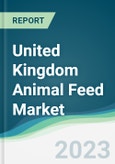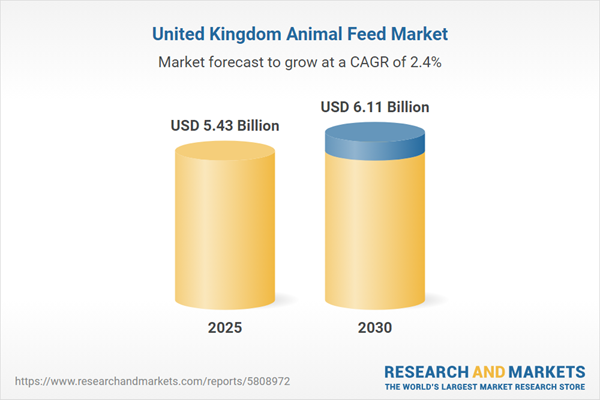The United Kingdom animal feed market is projected to grow at a CAGR of 2.40% over the forecast period, increasing from US$5.43 billion in 2025 to US$6.11 billion by 2030.
Animal feed is a type of food that is especially given to domesticated animals or livestock. This feed contains a balanced mixture of all the necessary nutrients and vitamins required for the growth of the livestock. It offers multiple benefits to the farmers or livestock owners, as it prevents the animals from any diseases, boosts production, and improves the quality of animal products like poultry, eggs, and dairy.
The growing demand for animal products, like milk, eggs, and meat, across the nation is boosting the need for animal feed in the UK.
With the increasing demand for animal products, the population of livestock will increase significantly, increasing the production of output of such products. The Department for Environment, Food & Rural Affairs of the UK government, in its report, stated that the production of animal products increased significantly in the region. The department stated that in 2021, the total value of production of meat products was recorded at EUR 9.46 billion, which increased to EUR 10.32 billion in 2022. In 2023, the total value of production of meat products reached EUR 10.92 billion.
Furthermore, the United Kingdom's animal feed market is estimated to grow at a steady rate during the forecast period. A key factor propelling the market forward is the increasing population of livestock across the region. Furthermore, the growing demand for animal products nationwide will also ensure its growth.
A key factor propelling the animal feed market's growth in the UK is the growing population of animals or livestock in the nation. The United Kingdom witnessed massive growth in its livestock farming practices, mainly due to the increasing global demand for animal products.
With the increase in the nation's livestock farming practices, the population of livestock grew significantly over the past few years. The Department of Environment, Food & Rural Affairs, in its report of 2024, stated that the total population of cattle and calves in the nation was recorded at 9.55 million heads, of which 1.83 million were dairy cows and 1,407 were beef cows. Similarly, the total population of pigs sheep, and lambs was recorded at 4.68 million heads and 31.80 million heads, respectively.
Animal feed is a type of food that is especially given to domesticated animals or livestock. This feed contains a balanced mixture of all the necessary nutrients and vitamins required for the growth of the livestock. It offers multiple benefits to the farmers or livestock owners, as it prevents the animals from any diseases, boosts production, and improves the quality of animal products like poultry, eggs, and dairy.
The growing demand for animal products, like milk, eggs, and meat, across the nation is boosting the need for animal feed in the UK.
With the increasing demand for animal products, the population of livestock will increase significantly, increasing the production of output of such products. The Department for Environment, Food & Rural Affairs of the UK government, in its report, stated that the production of animal products increased significantly in the region. The department stated that in 2021, the total value of production of meat products was recorded at EUR 9.46 billion, which increased to EUR 10.32 billion in 2022. In 2023, the total value of production of meat products reached EUR 10.92 billion.
Furthermore, the United Kingdom's animal feed market is estimated to grow at a steady rate during the forecast period. A key factor propelling the market forward is the increasing population of livestock across the region. Furthermore, the growing demand for animal products nationwide will also ensure its growth.
United Kingdom's animal feed market drivers
The rising population of livestock is anticipated to fuel the United Kingdom's animal feed market expansion.A key factor propelling the animal feed market's growth in the UK is the growing population of animals or livestock in the nation. The United Kingdom witnessed massive growth in its livestock farming practices, mainly due to the increasing global demand for animal products.
With the increase in the nation's livestock farming practices, the population of livestock grew significantly over the past few years. The Department of Environment, Food & Rural Affairs, in its report of 2024, stated that the total population of cattle and calves in the nation was recorded at 9.55 million heads, of which 1.83 million were dairy cows and 1,407 were beef cows. Similarly, the total population of pigs sheep, and lambs was recorded at 4.68 million heads and 31.80 million heads, respectively.
Reasons for buying this report:
- Insightful Analysis: Gain detailed market insights covering major as well as emerging geographical regions, focusing on customer segments, government policies and socio-economic factors, consumer preferences, industry verticals, other sub-segments.
- Competitive Landscape: Understand the strategic maneuvers employed by key players globally to understand possible market penetration with the correct strategy.
- Market Drivers & Future Trends: Explore the dynamic factors and pivotal market trends and how they will shape up future market developments.
- Actionable Recommendations: Utilize the insights to exercise strategic decision to uncover new business streams and revenues in a dynamic environment.
- Caters to a Wide Audience: Beneficial and cost-effective for startups, research institutions, consultants, SMEs, and large enterprises.
What do businesses use our reports for?
Industry and Market Insights, Opportunity Assessment, Product Demand Forecasting, Market Entry Strategy, Geographical Expansion, Capital Investment Decisions, Regulatory Framework & Implications, New Product Development, Competitive IntelligenceReport Coverage:
- Historical data & forecasts from 2022 to 2030
- Growth Opportunities, Challenges, Supply Chain Outlook, Regulatory Framework, Customer Behaviour, and Trend Analysis
- Competitive Positioning, Strategies, and Market Share Analysis
- Revenue Growth and Forecast Assessment of segments and regions including countries
- Company Profiling (Strategies, Products, Financial Information, and Key Developments among others)
The United Kingdom's animal feed market is analyzed into the following segments:
By Type
- Fodder
- Forage
- Compound Feed
By Livestock
- Pork
- Aquatic Animals
- Cattle
- Poultry
- Others
By Raw Material
- Soya
- Wheat
- Rendered Meal
- Others
By Production Systems
- Integrated
- Commercial Mills
Table of Contents
1. INTRODUCTION
2. RESEARCH METHODOLOGY
3. EXECUTIVE SUMMARY
4. MARKET DYNAMICS
5. UNITED KINGDOM ANIMAL FEED MARKET BY TYPE
6. UNITED KINGDOM ANIMAL FEED MARKET BY LIVESTOCK
7. UNITED KINGDOM ANIMAL FEED MARKET BY RAW MATERIAL
8. UNITED KINGDOM ANIMAL FEED MARKET BY PRODUCTION SYSTEMS
9. COMPETITIVE ENVIRONMENT AND ANALYSIS
10. COMPANY PROFILES
Companies Mentioned
- DSM Firmenich
- Archer Daniels Midland
- BASF SE
- Kemin Industries, Inc.
- WL Duffield & Sons Ltd.
- GLW Feeds
- Midland Feeds
- World Feeds Ltd.
- ABN (AB Agri)
- Cargill, Incorporated
Methodology

LOADING...
Table Information
| Report Attribute | Details |
|---|---|
| No. of Pages | 85 |
| Published | December 2024 |
| Forecast Period | 2025 - 2030 |
| Estimated Market Value ( USD | $ 5.43 Billion |
| Forecasted Market Value ( USD | $ 6.11 Billion |
| Compound Annual Growth Rate | 2.4% |
| Regions Covered | United Kingdom |
| No. of Companies Mentioned | 10 |









